1. Kazakov DV, Burg G, Kempf W. Clinicopathological spectrum of mycosis fungoides. J Eur Acad Dermatol Venereol. 2004; 18:397–415. PMID:
15196152.

2. van Doorn R, Van Haselen CW, van Voorst Vader PC, Geerts ML, Heule F, de Rie M, et al. Mycosis fungoides: disease evolution and prognosis of 309 Dutch patients. Arch Dermatol. 2000; 136:504–510. PMID:
10768649.
3. Jang MS, Kang DY, Park JB, Kim JH, Park KA, Rim H, et al. Pityriasis lichenoides-like mycosis fungoides: clinical and histologic features and response to phototherapy. Ann Dermatol. 2016; 28:540–547. PMID:
27746631.

4. Muniesa C, Estrach T, Pujol RM, Gallardo F, Garcia-Muret P, Climent J, et al. Folliculotropic mycosis fungoides: clinicopathological features and outcome in a series of 20 cases. J Am Acad Dermatol. 2010; 62:418–426. PMID:
20079954.

5. Aydogan K, Yazici S, Balaban Adim S, Tilki Gunay I, Budak F, Saricaoglu H, et al. Efficacy of low-dose ultraviolet a-1 phototherapy for parapsoriasis/early-stage mycosis fungoides. Photochem Photobiol. 2014; 90:873–877. PMID:
24502428.

6. Lehman JS, Cook-Norris RH, Weed BR, Weenig RH, Gibson LE, Weaver AL, et al. Folliculotropic mycosis fungoides: single-center study and systematic review. Arch Dermatol. 2010; 146:607–613. PMID:
20566923.
7. Gerami P, Rosen S, Kuzel T, Boone SL, Guitart J. Folliculotropic mycosis fungoides: an aggressive variant of cutaneous T-cell lymphoma. Arch Dermatol. 2008; 144:738–746. PMID:
18559762.
8. van Doorn R, Scheffer E, Willemze R. Follicular mycosis fungoides, a distinct disease entity with or without associated follicular mucinosis: a clinicopathologic and follow-up study of 51 patients. Arch Dermatol. 2002; 138:191–198. PMID:
11843638.

9. Gerami P, Guitart J. The spectrum of histopathologic and immunohistochemical findings in folliculotropic mycosis fungoides. Am J Surg Pathol. 2007; 31:1430–1438. PMID:
17721200.

10. Amitay-Laish I, Feinmesser M, Ben-Amitai D, Fenig E, Sorin D, Hodak E. Unilesional folliculotropic mycosis fungoides: a unique variant of cutaneous lymphoma. J Eur Acad Dermatol Venereol. 2016; 30:25–29.

11. Cerroni L. Skin lymphoma: the illustrated guide. 4th ed. Oxford: Wiley-Blackwell;2014.
12. Jang MS, Kang DY, Park JB, Han SH, Lee KH, Kim JH, et al. Clinicopathological manifestations of ichthyosiform mycosis fungoides. Acta Derm Venereol. 2016; 96:100–101. PMID:
26062766.

13. Hur J, Seong JY, Choi TS, Jang JG, Jang MS, Suh KS, et al. Mycosis fungoides presenting as Ofuji's papuloerythroderma. J Eur Acad Dermatol Venereol. 2002; 16:393–396. PMID:
12224701.

14. Jang MS, Kang DY, Han SH, Park JB, Kim ST, Suh KS. CD25+ folliculotropic Sézary syndrome with CD30+ large cell transformation. Australas J Dermatol. 2014; 55:e4–e8. PMID:
23190349.

15. Oppen K, Bjerner J, Buchmann M, Piehler AP. Incidental findings of monoclonal proteins from carbohydrate-deficient transferrin analysis using capillary electrophoresis. Clin Chem Lab Med. 2017; 55:e133–e136. PMID:
27816951.

16. Agar NS, Wedgeworth E, Crichton S, Mitchell TJ, Cox M, Ferreira S, et al. Survival outcomes and prognostic factors in mycosis fungoides/Sézary syndrome: validation of the revised International Society for Cutaneous Lymphomas/ European Organisation for Research and Treatment of Cancer staging proposal. J Clin Oncol. 2010; 28:4730–4739. PMID:
20855822.
17. Benner MF, Jansen PM, Vermeer MH, Willemze R. Prognostic factors in transformed mycosis fungoides: a retrospective analysis of 100 cases. Blood. 2012; 119:1643–1649. PMID:
22160616.

18. van Santen S, Roach RE, van Doorn R, Horváth B, Bruijn MS, Sanders CJ, et al. Clinical Staging and Prognostic Factors in Folliculotropic Mycosis Fungoides. JAMA Dermatol. 2016; 152:992–1000. PMID:
27276223.

19. Klemke CD, Dippel E, Assaf C, Hummel M, Stein H, Goerdt S, et al. Follicular mycosis fungoides. Br J Dermatol. 1999; 141:137–140. PMID:
10417530.

20. Breuckmann F, von Kobyletzki G, Avermaete A, Radenhausen M, Höxtermann S, Pieck C, et al. Mechanisms of apoptosis: UVA1-induced immediate and UVB-induced delayed apoptosis in human T cells in vitro. J Eur Acad Dermatol Venereol. 2003; 17:418–429. PMID:
12834452.
21. Weichenthal M, Schwarz T. Phototherapy: how does UV work? Photodermatol Photoimmunol Photomed. 2005; 21:260–266. PMID:
16149939.

22. Tewari A, Grage MM, Harrison GI, Sarkany R, Young AR. UVA1 is skin deep: molecular and clinical implications. Photochem Photobiol Sci. 2013; 12:95–103. PMID:
23192740.

23. Yamauchi R, Morita A, Yasuda Y, Grether-Beck S, Klotz LO, Tsuji T, et al. Different susceptibility of malignant versus nonmalignant human T cells toward ultraviolet A-1 radiation-induced apoptosis. J Invest Dermatol. 2004; 122:477–483. PMID:
15009733.

24. Olek-Hrab K, Silny W, Dańczak-Pazdrowska A, Osmola-Mańkowska A, Sadowska PA, Polańska A, et al. Ultraviolet A1 phototherapy for mycosis fungoides. Clin Exp Dermatol. 2013; 38:126–130. PMID:
23082901.

25. Kim ST, Kang DY, Kang JS, Baek JW, Jeon YS, Suh KS. Photodynamic therapy with methyl-aminolaevulinic acid for mycosis fungoides. Acta Derm Venereol. 2012; 92:264–268. PMID:
22170261.

26. Debu A, Bessis D, Girard C, Du Thanh A, Guillot B, Dereure O. Photodynamic therapy with methyl aminolaevulinate for cervical and/or facial lesions of folliculotropic mycosis fungoides: interest and limits. Br J Dermatol. 2013; 168:896–898. PMID:
23013351.

27. Wiegell SR, Wulf HC. Photodynamic therapy of acne vulgaris using 5-aminolevulinic acid versus methyl aminolevulinate. J Am Acad Dermatol. 2006; 54:647–651. PMID:
16546587.




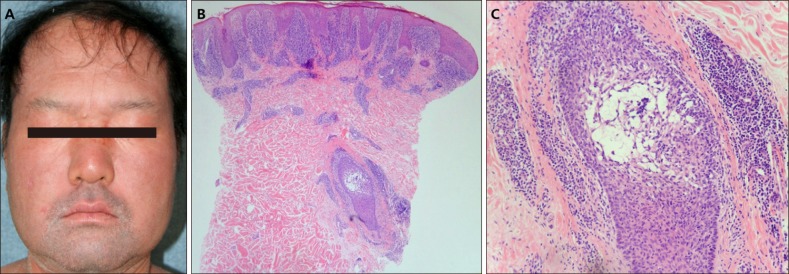
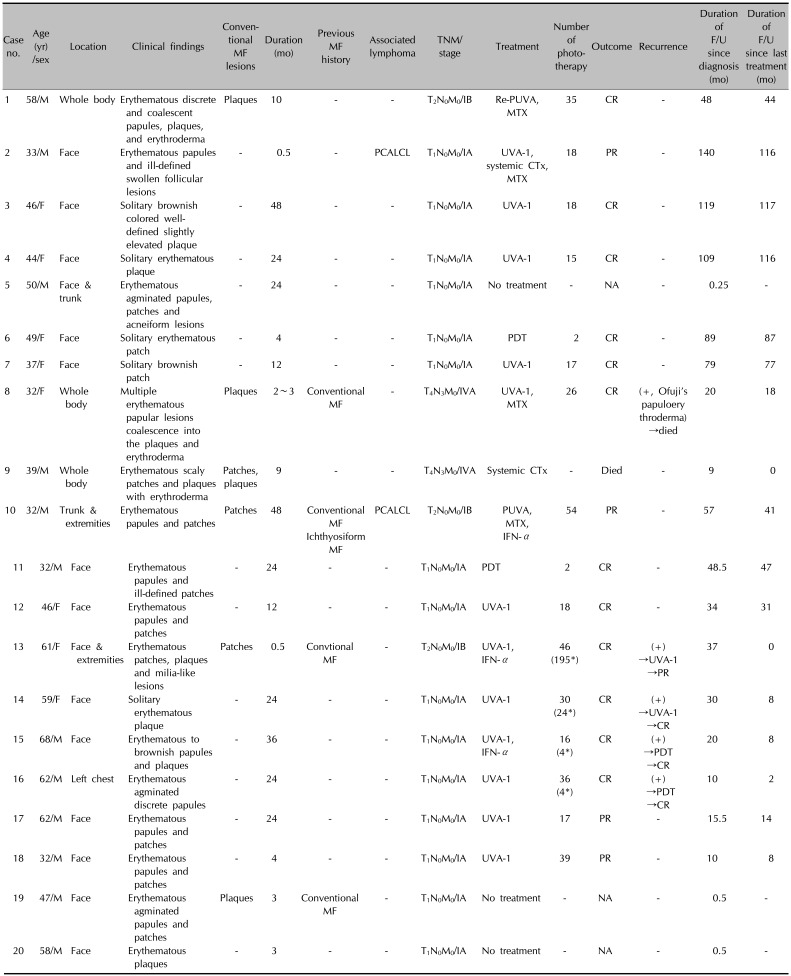
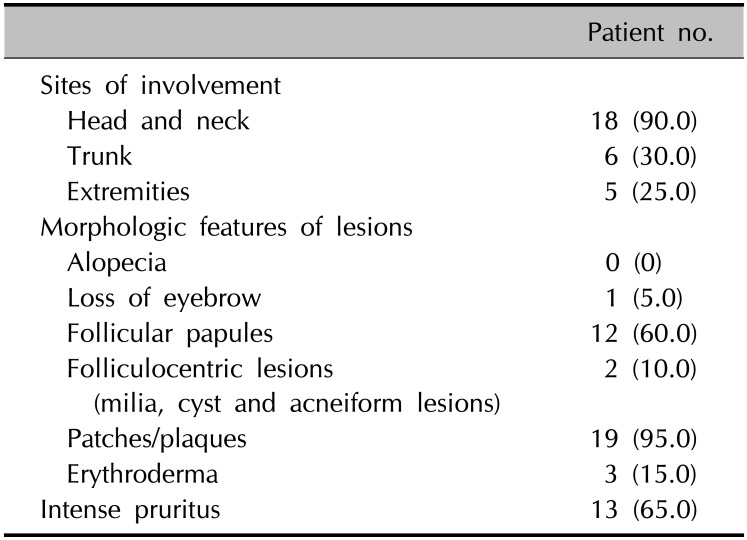
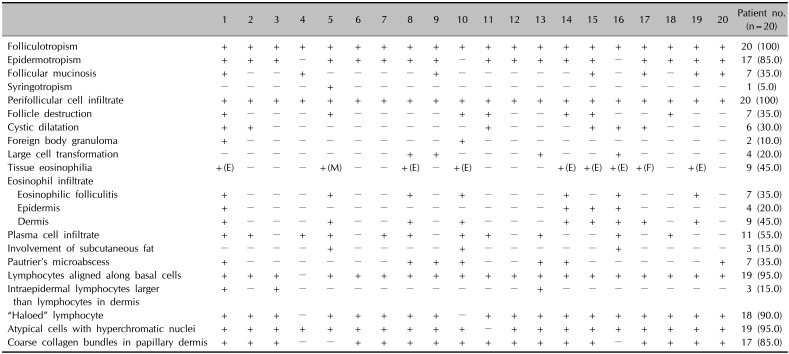




 PDF
PDF ePub
ePub Citation
Citation Print
Print


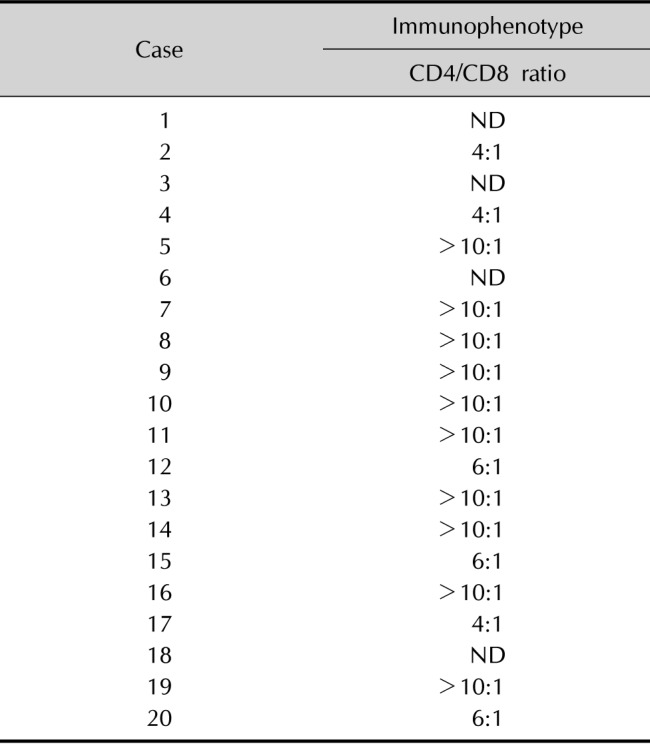
 XML Download
XML Download